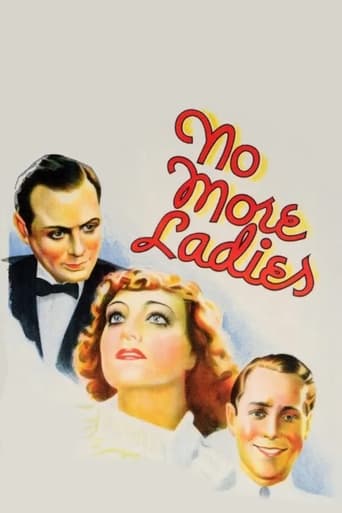

Robert Montgomery plays a rich guy without much character. Most of the time, he'd prefer to be chasing skirts. So, when his girlfriend (Joan Crawford) is bored, they decide to get married--even though Robert's track record with serious relationships is horrendous. A short time after the marriage, Robert decides to start chasing other women--leaving poor Joan to cry and bemoan her fate. Considering he never pretended to be anything else other than a shallow ladies man, it seemed odd that she was so saddened by his predictable behavior.So far in the film, I was not impressed. The characters either seemed selfish and unlikable (Montgomery) or hopelessly stupid (Crawford). For comic relief, Charlie Ruggles did a bad drunk characterization that was supposed to be cute but frankly just annoyed me. So considering that I kept watching the film is a bit of a surprise.Fortunately, the film did get much better. Instead of whining at length, Joan came up with a clever plan to try to win back her husband's love and attention. While this was much more watchable, I kept thinking to myself "why would she want him back?!", but despite this it at least kept my interest.The bottom line is that I had a hard time caring about the character (especially since rich folks who make themselves miserable are hard to relate to or worry about). Because of this, the film definitely falls into the "time passer" category and not much more. Fans of the actors may want to tune it, but others probably can just skip this one. There are just better films out there from this time period--ones that will engage you.
... View MoreThough the careers of Robert Montgomery, Joan Crawford, and her husband at the time, Franchot Tone's respective careers were not hurt by films like No More Ladies, this was the kind of stuff all three of these players were looking to get out of.There was a truism at MGM back in its heyday. For films where the men wear tuxedos you first get Robert Montgomery. If he turns it down get Franchot Tone. If it's bad enough for Tone to turn it down God help him, Robert Young is stuck with it. So knowing the pecking order and knowing the billing, you can guess who Crawford winds up with.Robert Montgomery plays another of those irrepressible womanizing playboys who's sowed enough wild oats to qualify for a farm subsidy. He's decided to settle down with society girl Joan Crawford who has certain ideas about infidelity and how wrong it is. Montgomery behaves at first, but when he uses their perpetually inebriated friend Charlie Ruggles as an alibi that doesn't hold up, Crawford decides on some revenge with Franchot Tone.No More Ladies is harmless enough and when Edna May Oliver as Joan's grandmother is on the screen, always entertaining. But it was the stuff that MGM was grinding out in its dream factory. It was a case of Montgomery and Tone look great in tuxedos so cast them as urban playboys.Well, both of them did look great, Louis B. Mayer wasn't wrong about that.
... View MoreYou've seen it all before, folks--another tiresome romantic comedy, unredeemed by an accomplished cast and the trademark MGM gloss. Joan Crawford is especially wasted in the airy proceedings; her dramatic intensity has no outlet here, and she is forced to rely on her lesser skills as a sophisticated comedienne. This is Carole/Claudette/Irene territory, and, although Joan can give these ladies cards in spades when it comes to glamour, she lacks their lighter touch. I suspect two forces were at work here: the Production Code of 1933, which forced out earthy drama and bawdy comedy and pushed stars like Harlow and Crawford into fluff, and the "Norma" syndrome at MGM, which forced Crawford to take Norma's castoff parts. (No wonder Joan ended up "box-office poison" shortly after pictures like this alienated her fan base!) If you'd like to see Joan in comedies more suited to her persona, check out her splendidly bitchy Crystal in "The Women", or as the clueless Susan in "Susan and God".
... View MoreThe unoriginal plot, about a rich married couple dealing with problems of infidelity, is secondary here to the clever dialogue by Donald Ogden Stewart, who wrote the screenplay to The Philadelphia Story, and to a strong supporing cast. Joan Crawford is fine, but Robert Montgomery and Franchot Tone, fighting for Crawford's hand, wind up being nearly indistinguishable from each other, both in looks and in character. That leaves the supporting cast to rescue the film: Charles Ruggles has a fun bit as a slurring drunk and Arthur Treacher comes in at the end as a stuffy Brit who mumbles loudly and misuses American slang. Even Gail Patrick, who isn't normally given much to do in her man-stealing parts, is fine here. But the best is Edna May Oliver, playing the wise and witty matriarch--she steals every scene she's in and was the main reason I finished watching the movie.
... View More